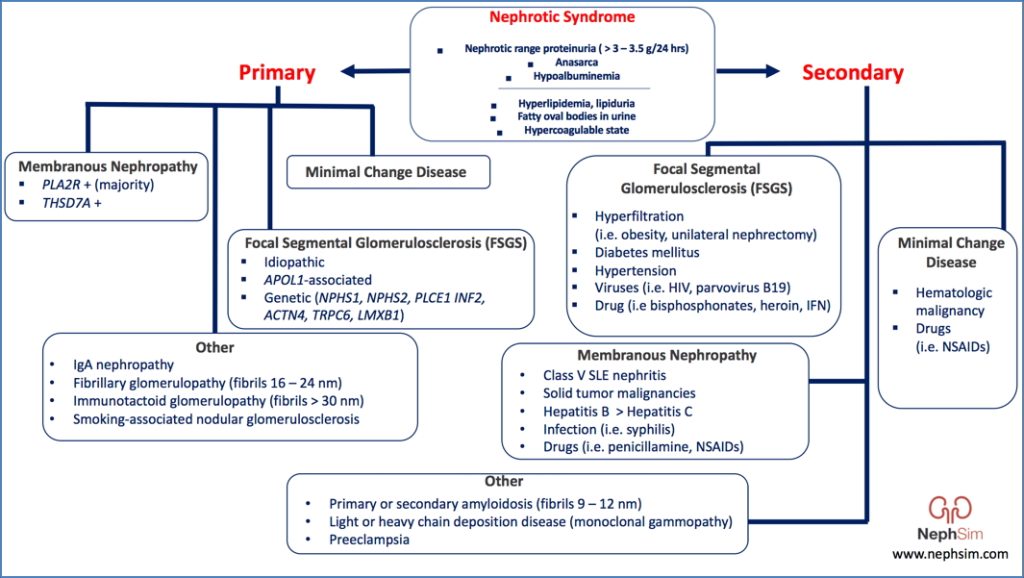Table of Contents
Overview – Nephrotic Syndrome
Nephrotic syndrome refers to a clinical condition resulting from increased glomerular permeability, allowing proteins to leak into the urine. This syndrome is typically caused by a range of glomerular diseases and presents with a characteristic triad of massive proteinuria, hypoalbuminemia, and oedema. It is an important differential in patients presenting with generalised oedema or frothy urine and can be a key manifestation of systemic illnesses or primary renal pathology. Understanding the shared pathophysiology and complications of nephrotic syndrome is essential before diving into its many specific causes.
Definition
Nephrotic syndrome is a collection of clinical findings arising from glomerular damage that increases protein loss in the urine:
- Proteinuria: >3.5 g/day (Nephrotic range)
- Hypoalbuminemia: Due to urinary albumin loss
- Oedema: Especially periorbital; caused by ↓ plasma oncotic pressure
- Hyperlipidaemia: Hepatic lipoprotein synthesis increases in response to low oncotic pressure
- Lipiduria: May be present (fatty casts in urine)
Clinical Features
- Reduced GFR
- Polyuria
- Massive Proteinuria (>3000 mg/day)
- → Granular (Protein) Casts in urine
- → Oedema (especially periorbital)
- → Hypercoagulability (loss of Antithrombin-III in urine)
- → Immunocompromise (loss of immunoglobulins)
- → Hyperlipidaemia (hepatic compensation for ↓ plasma osmolality)
- Mildly elevated serum creatinine
- Note: Patients are dehydrated due to polyuria, but oedematous due to proteinuria
Investigations
- Urinalysis:
- +++ Proteinuria
- Granular casts
- Bloods:
- ↓ Albumin
- ↑ Lipids
- ↑ Creatinine (mild)
- Serological tests (if secondary cause suspected)
- Renal biopsy: Often needed for definitive diagnosis
Management
- Diuretics (e.g. frusemide): Reduce oedema
- ACE Inhibitors: Lower intraglomerular pressure and proteinuria
- Statins: If hyperlipidaemia is significant
- Heparin: For thromboembolism prophylaxis if hypercoagulable
- Immunosuppressants: (e.g. cyclophosphamide, prednisone) for immune-mediated cases
- Dietary modifications:
- Low salt intake
- Reduce saturated fat
Complications
- Thromboembolism (due to antithrombin III loss)
- Infections (especially peritonitis, due to immunoglobulin loss)
- Acute Kidney Injury
- Progression to CKD or ESRF
- Hyperlipidaemia-related cardiovascular risk
Causes of Nephrotic Syndrome
Nephrotic syndrome can be primary (renal-limited) or secondary to systemic disease.
Primary Causes:
- Minimal Change Disease – most common in children
- Focal Segmental Glomerulosclerosis (FSGS) – common in adults
- Membranous Glomerulonephritis (MGN) – common in adults
- Other glomerulopathies (e.g. IgA nephropathy, amyloidosis)
Secondary Causes:
- Diabetes Mellitus (diabetic nephropathy)
- Systemic Lupus Erythematosus (SLE)
- Infections (e.g. Hep B/C, HIV)
- Malignancy
- NSAIDs
- Amyloidosis
For full details on individual causes, explore our disease-specific pages linked from this overview.

Summary – Nephrotic Syndrome
Nephrotic syndrome is a high-yield renal condition caused by increased glomerular permeability, resulting in heavy proteinuria, oedema, and hypoalbuminaemia. Understanding the shared features of nephrotic syndromes is crucial before studying their specific causes such as minimal change disease, FSGS, and membranous nephropathy. For further reading, head to our Renal Overview page.